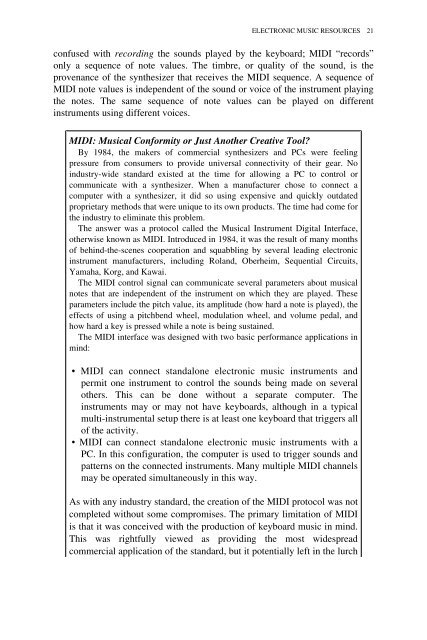Electronic and Experimental Music: Pioneers in ... - Aaaaarg
Electronic and Experimental Music: Pioneers in ... - Aaaaarg
Electronic and Experimental Music: Pioneers in ... - Aaaaarg
Create successful ePaper yourself
Turn your PDF publications into a flip-book with our unique Google optimized e-Paper software.
ELECTRONIC MUSIC RESOURCES 21<br />
confused with record<strong>in</strong>g the sounds played by the keyboard; MIDI “records”<br />
only a sequence of note values. The timbre, or quality of the sound, is the<br />
provenance of the synthesizer that receives the MIDI sequence. A sequence of<br />
MIDI note values is <strong>in</strong>dependent of the sound or voice of the <strong>in</strong>strument play<strong>in</strong>g<br />
the notes. The same sequence of note values can be played on different<br />
<strong>in</strong>struments us<strong>in</strong>g different voices.<br />
MIDI: <strong>Music</strong>al Conformity or Just Another Creative Tool?<br />
By 1984, the makers of commercial synthesizers <strong>and</strong> PCs were feel<strong>in</strong>g<br />
pressure from consumers to provide universal connectivity of their gear. No<br />
<strong>in</strong>dustry-wide st<strong>and</strong>ard existed at the time for allow<strong>in</strong>g a PC to control or<br />
communicate with a synthesizer. When a manufacturer chose to connect a<br />
computer with a synthesizer, it did so us<strong>in</strong>g expensive <strong>and</strong> quickly outdated<br />
proprietary methods that were unique to its own products. The time had come for<br />
the <strong>in</strong>dustry to elim<strong>in</strong>ate this problem.<br />
The answer was a protocol called the <strong>Music</strong>al Instrument Digital Interface,<br />
otherwise known as MIDI. Introduced <strong>in</strong> 1984, it was the result of many months<br />
of beh<strong>in</strong>d-the-scenes cooperation <strong>and</strong> squabbl<strong>in</strong>g by several lead<strong>in</strong>g electronic<br />
<strong>in</strong>strument manufacturers, <strong>in</strong>clud<strong>in</strong>g Rol<strong>and</strong>, Oberheim, Sequential Circuits,<br />
Yamaha, Korg, <strong>and</strong> Kawai.<br />
The MIDI control signal can communicate several parameters about musical<br />
notes that are <strong>in</strong>dependent of the <strong>in</strong>strument on which they are played. These<br />
parameters <strong>in</strong>clude the pitch value, its amplitude (how hard a note is played), the<br />
effects of us<strong>in</strong>g a pitchbend wheel, modulation wheel, <strong>and</strong> volume pedal, <strong>and</strong><br />
how hard a key is pressed while a note is be<strong>in</strong>g susta<strong>in</strong>ed.<br />
The MIDI <strong>in</strong>terface was designed with two basic performance applications <strong>in</strong><br />
m<strong>in</strong>d:<br />
MIDI can connect st<strong>and</strong>alone electronic music <strong>in</strong>struments <strong>and</strong><br />
permit one <strong>in</strong>strument to control the sounds be<strong>in</strong>g made on several<br />
others. This can be done without a separate computer. The<br />
<strong>in</strong>struments may or may not have keyboards, although <strong>in</strong> a typical<br />
multi-<strong>in</strong>strumental setup there is at least one keyboard that triggers all<br />
of the activity.<br />
MIDI can connect st<strong>and</strong>alone electronic music <strong>in</strong>struments with a<br />
PC. In this configuration, the computer is used to trigger sounds <strong>and</strong><br />
patterns on the connected <strong>in</strong>struments. Many multiple MIDI channels<br />
may be operated simultaneously <strong>in</strong> this way.<br />
As with any <strong>in</strong>dustry st<strong>and</strong>ard, the creation of the MIDI protocol was not<br />
completed without some compromises. The primary limitation of MIDI<br />
is that it was conceived with the production of keyboard music <strong>in</strong> m<strong>in</strong>d.<br />
This was rightfully viewed as provid<strong>in</strong>g the most widespread<br />
commercial application of the st<strong>and</strong>ard, but it potentially left <strong>in</strong> the lurch












